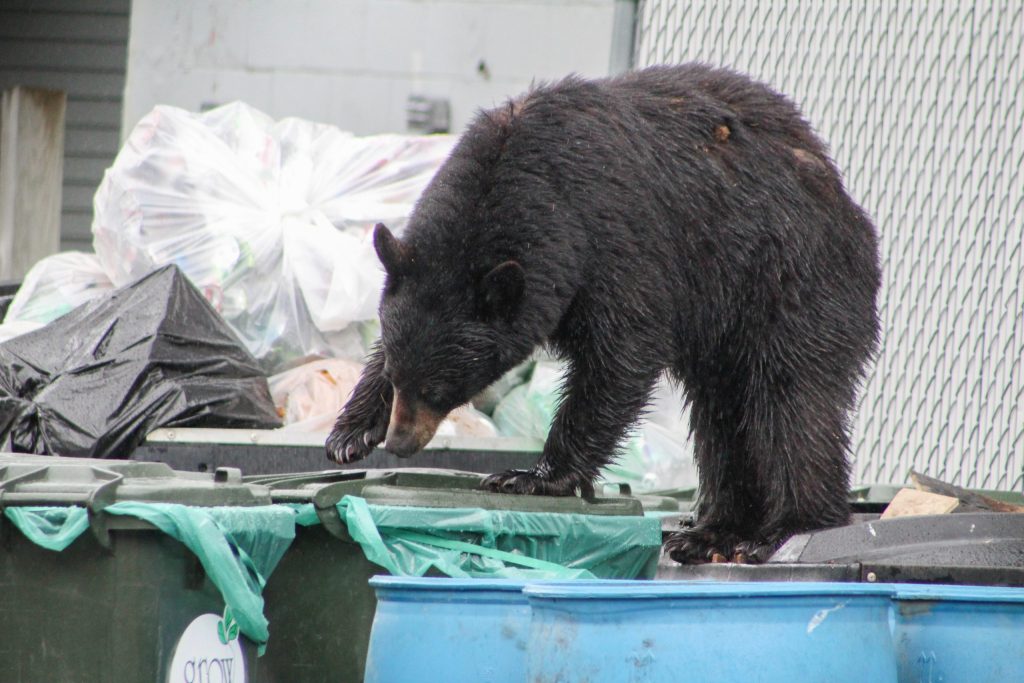Vermont game warden Jeremy Schmid got a call last Friday about an aggressive bear in Underhill. When he arrived at the scene, Schmid easily recognized the 100-pound animal. It was a repeat offender, attracted that morning by recycling outside the front door of the house.
“Warden Schmid decided to euthanize the bear for concerns with public safety,” said Lt. Robert Currier, the Northwestern district’s head game warden for the state Fish and Wildlife Department.
Currier also noted that the animal had previously “displayed similar aggressive behavior towards another homeowner in the area.”
Jaclyn Comeau, the department’s black bear project leader, called this earlier incident “unique.”
“That bear had actually displayed predatory behaviors,” she said, calling it “an exceptionally rare thing, for a black bear.” The bear, she explained, was “following and trying to sneak up on that person.” In other words, she said, “stalking behavior.”
Currier said the decision to euthanize is never easy and is always made on a “case-by-case basis.”
In Underhill on Friday morning, he said, the bear began to approach and circle Schmid “in a predatory stance,” while “chomping his jaws several times.” For Currier, this behavior is concretely aggressive.
“No one wants to see their conflicts escalate to the point that killing the bear is necessary to protect public safety,” he said.
That’s not a common outcome, according to Comeau. Last year, she said, with over 900 reports of human-bear interactions in the state, the Fish and Wildlife Department killed just two bears in conflict situations of this kind.
“Some folks,” she added, “will take matters into their own hands,” and kill an aggressive bear themselves. In fact, this is significantly more frequent: There were 23 such recorded incidents last year entirely separate from hunting, she said.
Comeau urged homeowners to call their game wardens before taking action themselves. “We do have legal protections for bears,” she said.
The number of reports of bears interacting with humans represents a staggering increase since a decade ago.
Up until 2016, Comeau said, she would expect around 130 reports from the public each year. Then, she said, that number began to climb, with 1,700 reports in 2020, and 1,400 in 2022.
Although the numbers have since dipped, they have not returned to pre-pandemic levels, she said. She described last year, with 900 reports, as “the craziest ‘quiet year’ we’ve had.”
And while the department said in October 2023 that the Vermont bear population had hit a five-year high, Comeau doesn’t think that’s the cause of this new normal.
“We have a lot of bears in pretty much every Vermont community that are what we call ‘food-conditioned’…regularly searching for human foods,” she said.
Fully 40% of the annual bear reports and sightings she and her colleagues receive involve bears trying to access trash, according to the department. Bird feeders and backyard chickens without electric fencing also cause problems.
“Once these behaviors start, they usually are repeated,” said Comeau.
Studies have also observed food-conditioned bears “starting to reproduce younger [and in] larger litter sizes,” according to Comeau, though they may also have higher mortality rates.
“It’s going to be on us to change our behavior,” she said, adding that if Vermonters can limit bears’ access to human food, “bears will shift back to the woods and foraging for wild foods.”
Some of bears’ behavioral shifts are less controllable. Comeau said that climate change is extending bear season noticeably as the state warms. Everyone, she emphasized, needs to take “bear-aware precautions for more months out of the year now than we used to have to.”
The Fish and Wildlife Department has published instructions surrounding homeowner bear safety on its website. It also warns that intentionally feeding bears is a violation of state law, which Lt. Currier said could result in a $435 fine, and a year’s suspension of hunting and fishing licenses.
“Vermonters have a responsibility to stop these kinds of conflicts,” said Currier. “Proactive conflict prevention is the safest thing for bears, and for people.”
Read the story on VTDigger here: Bear euthanized in Underhill displayed ‘exceptionally rare’ predatory behavior.

